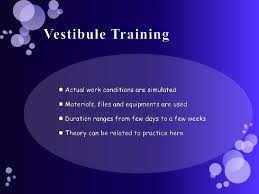Training - objectives:
* to impart knowledgeknowledge
* to sharpen the skills
* to understand the trends in technology and application
* to instruct the employees about safety measures
* to keep abreast of the changing methods, techniques
* to reduce waste and spoilage of materials, ti reduce supervision time so as to enable to do the work in a more effective way.
Program: health awareness
Objectives: to spread awareness about the diseases and prevention methods.
***
Program: holistic health
Objectives: to lead a peaceful and improved quality of life
***
Program: interpersonal relations
Objectives: for achieving harmony life
***
Program: change management
Objectives: attitudes to change in business environment and to be modified employees behaviour patterns.
***
Program: work culture
Objectives: to improve the quality of work life.
***
Program: executives development
Objectives: to improve managerial skills with emphasis on motivation creativity and communication.
*"*
Program: leadership development
Objectives: to impart knowledge and skills to develop leadership qualities.
***
Program: management development
Objectives: to develop senior and middle management
***
Program: managerial excellence
Objectives: to face challenges and changes and to be successful .
***
Program: time management
Objectives: to impact latest time management
***






























